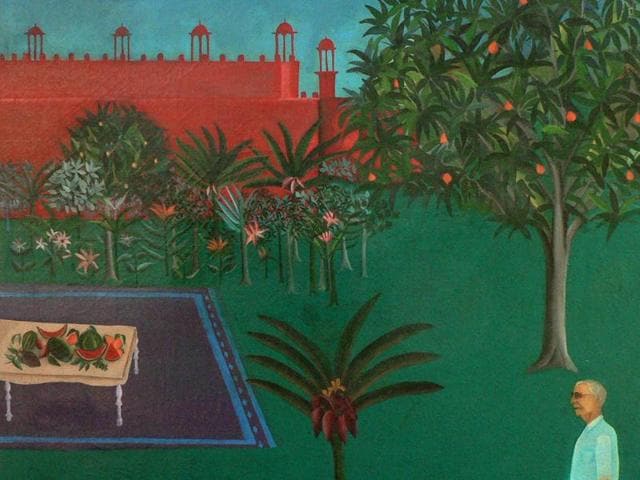Personal connection: The many facets of artist Bhupen Khakhar
The National Gallery of Modern Art showcases the intimate world of Baroda artist Bhupen Khakhar
A great modern Indian artist, Bhupen Khakhar’s (1934-2003) taste was for the popular and the bazaar. A career chartered accountant, barring the last 10 years of his life, Khakhar, a man of Bombay and Baroda, stayed clear of the academic and learnt the way of the artist in the best of schools -- the streets. The barber at work on the corner of the pavement, the clerk stretching legs on a community park-bench, working men’s hostels, the paan-beedi shop, cinema hoardings… were all characters, objects and scenes of his very personalized, commentative art. The National Gallery of Modern Art (NGMA) showcases around 40 years of Khakhar’s artistic journey in a new exhibition titled ‘the many facets of an artist’. It exhibits 140 works in diverse media such as painting, print, installation, ceramic and mixed media, loaned from the collection of the Bhupen Khakhar Estate to NGMA for five years.

Read | Brush with art: Legends of Baroda come to Mumbai
“This exhibition is not just about what Khakhar created, but to show what interested him, his associations, and how these contributed to his language,” says Rajeev Lochan, director, NGMA.
Khakhar’s use of colour, for instance, is singular. It is unabashedly loud. Crimson reds, indigo blues, emerald greens abound. A collector of film memorabilia and popular art, their neon hues find their way in his work but his use of water considerably balanced out the colour-bursts; to his depiction of forts, factories, mills and interiors of middle and lower-middle class homes, he brought the meticulous detailing of Indian miniature paintings. That is, he took from all, but was influenced by none.
Read: All you need to know about the world of art and culture
Monumental cutouts of cine-stars Amitabh and Rekha illustrate how Khakhar viewed his art as a collaboration and an interpretation of the street. Art historian Geeta Kapur who was one of the curators of the ‘Century City’ exhibition for the 2001 inaugural show of Tate Modern, London, where these cutouts were for the first time exhibited, says Khakhar was interested in the public interest in popular icons. “Khakhar collaborated with a film hoarding painter in Baroda to paint one side of the cutout. On the other side, he painted his own narrative of urban life. It was his appropriation of Amitabh and Rekha’s images to make a larger comment on popular culture,” she says.
Khakhar’s works is also distinguished by the postures and gestures of his subjects – whether of his own in his self portraits or of other people. He seemed interested in the way the human body looked like from inside a painting. The bent of the shoulder, the tilt of the neck, the stretch of the torso, the cross-legged position while seating are sharply outlined. The exhibition which also features the last phase of Khakhar’s life in which his own body was attacked by cancer, also has many of the faces in his paintings marked with deep lesions, sores, bodies with guts spilled out -- men and women in a position of vulnerability.
Watch Rear Window: a video of Tariq Ali on Bhupen Khakhar in Paris
“He was unafraid to show wounds, be it physical, psychological or social,” says Kapur. “Bhupen Khakhar was drawing real people and real bodies. They are not constructed images.”
Many facets of an artist: Collections from the Bhupen Khakhar Estate is on at NGMA, Jaipur House, India Gate, till March 27, 10am-5pm.
Follow @htlifeandstyle for more.





